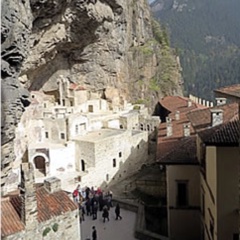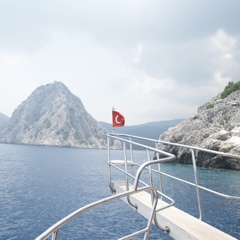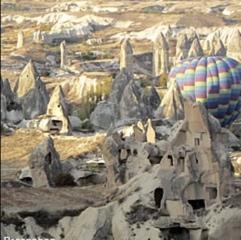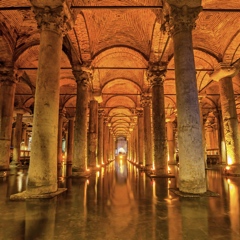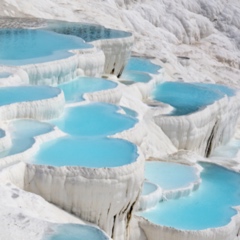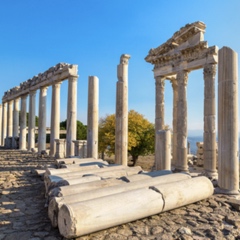Ancient Termessos Archaeological Site
Perched on the precipice of the gorgeous Güllük Mountains, the ancient city of Termessos provides one of the most stunning examples of ancient cities in Western Turkey. It is no wonder that even Alexander the Great (333 BC) recognized the challenge its sheer height posed and abandoned a lengthy battle to unleash his wrath on Sagalassos instead (Arrian 1.28). The ancient ruins, located in the Güllük Mountain (Termessos) National Park, offer a breathtaking hike through the ruins to the summit. The ancient city features a magnificent theater, the monumental tomb of Alcetas (one of Alexander’s generals), Hellenistic Defenses, multiple temples, as well as several magnificent necropolises. I suggest around 3-4 hours to explore the site and hike the trails fully. Even if you are not a huge history buff, this is a fantastic hiking spot with a scenic view of the Turkish countryside. See more detailed information about exploring the site below.

The city is relatively accessible from the major city of Antalya (~33 km/20.5 miles). You can also easily pair this city with exploring Karain Cave (19 km/12 miles east), in which archaeologists have found evidence of human occupation going back tens of thousands of years! While Termessos may take around half a day, you could combine it with visiting other ancient cities in the Antalya area like Aspendos, Perge, and Sillyon.
Güllük Dagi-Termessos National Park was added to the UNESCO World Heritage’s Tentative List in 2000.
Admission
To get to the Termessos Archaeological Site, you will first drive through the Güllük Mountain Termessos National Park and pay a small admission fee when you get to the park. Check the official museum website for updated information. Keep driving up the mountain to the end of the road, and you will see a small guard’s house and the parking lot. There are bathrooms near the parking lot. Be sure to check out the ruined Temple of Artemis/Harian Propyium, which is also near the parking lot. Beside the guardhouse are a general map and the path ascending to the ancient city.
There is no audio guide and no map in English. A few signs are scattered throughout the site, but they offer only directional information and no historical background.
Transport
It is possible to take a bus from Antalya city center, which will get you close to the Termessos Ruins and let you off at Aydinlar Mah. Park. From there, you can catch a cheap and quick 20-minute taxi up the mountain and through the Güllük Mountain Termessos National Park to where the ruins begin. You can also simply hire a taxi or rent a car for the entire trip. If you rent a car, you can easily swing by Karain Cave which is only a 30-minute drive away.


Historical Notes
Legend holds that Termessos was founded by the Solymi (likely a Pisidic tribe), who was opposed in battle by the hero Bellerophon riding Pegasus (according to the Iliad of Homer). However, Termessos entered into historical prominence when Alexander the Great attempted to conquer the city on his route through Asia Minor in 333 BC. Due to the mountainous terrain and gorges, the historian Arrian remarks that it was easily defended by only a small force (1.28). Not wanting to waste time, Alexander ordered his troops onward toward the city of Sagalassos, which he sacked. Thus, Termessos holds the distinction of being one of only two cities (the other being Sillyon) in the Pamphylian/Phrygian region that repelled the armies of Alexander the Great.
When Alexander died in 323 BC, Termessos was caught up in the Wars of the Diadochi as Alexander’s generals ripped apart his empire in a bloody power struggle. When the general Alcetas was defeated by his rival Antigonus in 320 BC, he fled to Termessos, where he was brutally murdered. The town's youth felt bad for this unlucky soldier and erected a magnificent monumental tomb which you can still visit to this day! It features a massive carving of a mounted Macedonian warrior etched into the cliff face.
Termessos would eventually fall under Roman control and features buildings dedicated to the Emperors of Rome. However, researchers believe that the city was ultimately abandoned when its aqueduct was destroyed in an earthquake cutting off the water supply.
Excavations and surveys of the site were first conducted by Austrian Count K. G. Lanckoroski and his team in 1884-85. Recently (2015), surveys and site mapping have been undertaken by the Istanbul Mimar Sinan University of Fine Arts Scientific Research Projects Unit. It is hoped that their research and investigation can bring more insight and knowledge about the site to the surface.
Brief Overview and Trail Notes
The trails throughout Termessos are clear and easily hiked but are not accessible for wheelchairs and may be difficult for small children.
As you hike up the trail, you will see the imposing Lower Defensive Walls. Researchers believe this section was part of a defensive encirclement that would have surrounded the entire city. You can then proceed through the City Gate and enter the city's central area.
On your left will be the Gymnasium and Roman Baths. Many sections of this are still under the earth, but you can still walk under the beautiful arches. Further up the trail and to your right will be the ramparts of the Upper City Defensives. The path then opens up to a scattered ruin of Roman Stela (containing both Greek and Latin script), fallen columns, and the remnants of a Roman street and drainage system.



Follow the road up to the left, and you will see signs for the Theater (may be marked “Tiyatro”). Next, you will walk past a building marked “Unidentified Building.” The Theater is absolutely stunning, with a magnificent mountain backdrop. Take your time exploring and climbing the steps down to the orchestra and stage.
When you exit, bear left, and you will come through the Roman Agora and see the massive walls of a Meeting Hall as well as a Minor Temple to Artemis. Continue along the trail to the temple's right, and you will see more columns and a Roman road. The road will split with the left being a trail to the House of a Benefactor, and to your right will be the Five Cisterns and a Heroon. The five cisterns are truly remarkable both in their size and depth!
Straight past the five cisterns, you will come to a large Corinthian Style Temple. You do not want to miss two critical sections past this temple! The trail forks and presents a route out to the Monumental Tomb of Alcetas and a path to the South-West Necropolis. You will also see a course back down towards the central ruins and scattered columns, which you can use on your way back.
The route to the Monumental Tomb of Alcetas features a beautiful sculpture of a mounted Macedonian soldier carved into the rock, along with other sculptures. It takes about 10-15 minutes from the temple to hike out to the tomb, but the view once you get there is well worth it! Note: there is a large water cistern halfway along the trail, which you may mistake for the tomb, but keep on going to actually get to it.
The trail marked for the South-Western Necropolis will take you up to the mountain's summit to a guard tower. Stunning clusters of sarcophagi with beautifully carved art and inscriptions line both sides of the trail. It is well worth it to explore this incredible collection of graves. Finish hiking up to the guard lookout tower (most likely locked), and you will be able to take a break and appreciate the stunning view! It will probably take you 15-20 minutes to reach the top.
There is much more to this site, so take your time wandering along the different routes and making your way back down!
—by Caleb Bowman; photos by Abigail Goosen


For More Information:
“Antalya Termessos Archaeological Site.” Turkish Museums. https://turkishmuseums.com/museum/detail/1974-antalya-termessos-archeological-site/1974/4
Arrian. “The Anabasis of Alexander” or “The History of the Wars and Conquests of Alexander the Great.” Translated by E. J. Chinnock. London: Butler & Tanner, 2014.
UNESCO. “Güllük Dagi-Termessos National Park.” 2000. https://whc.unesco.org/en/tentativelists/1412/
Öztürk, Arzu, Sevingül Bi̇lgi̇n, Kıvanç Başak, And İdil Malgi̇l. “Surveys at Termessos in 2015” In ANMED: News of Archaeology from Anatolia’s Mediterranean Areas #14. Istanbul: Koç University, 2016.
“Termessos Archaeological Site.” (Official website). https://muze.gov.tr/muze-detay?sectionId=TRM01&distId=TRM



